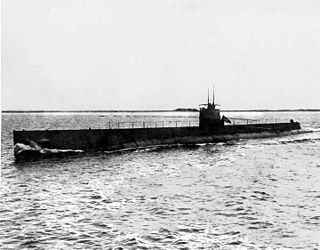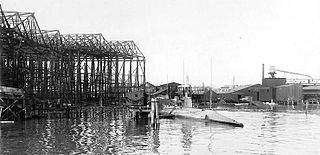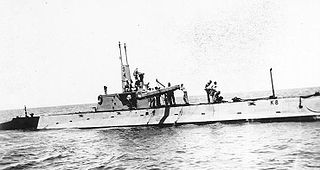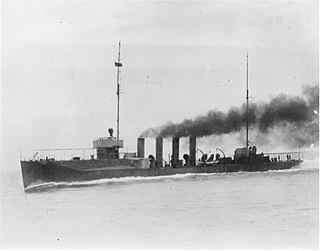
The Gato class of submarines were built for the United States Navy and launched in 1941–1943. Named after the lead ship of the class, USS Gato, they were the first mass-production U.S. submarine class of World War II.

USS Barbel (SS-580) was the lead ship of her class of submarines in the United States Navy. She was the second Navy ship named for the barbel, a cyprinoid fish, commonly called a minnow or carp.

The AA-1 class was a class of three experimental submarines of the United States Navy, built toward the end of World War I, between 1916 and 1919, intended to produce a high-speed fleet submarine. The design was not a success and none of the submarines saw active service. However, the lessons learned were applied to the design of the later V-boats. The class was later renamed as the T class.

The United States' S-class submarines, often simply called S-boats, were the first class of submarines with a significant number built to United States Navy designs. They made up the bulk of the USN submarine service in the interwar years and could be found in every theater of operations. While not considered fleet submarines, they were the first submarines in the USN designed for open ocean, blue water operations. All previous submarines had been intended for harbor or coastal defense. These boats were intended to have greater speed and range than previous classes, with improved habitability and greater armament.

USS R-25 (SS-102) was an R-class coastal and harbor defense submarine built for the United States Navy during World War I.

USS L-3 (SS-42) was an L-class submarine of the United States Navy.

USS K-1 (SS-32) was the lead ship of her class of submarine of the United States Navy. Originally named Haddock until renamed while under construction, she participated in World War I as a patrol sub off the coast of the Azores in southwest Europe.

USS K-2 (SS-33) was a K-class submarine, of the United States Navy. Her keel was laid down by Fore River Shipbuilding Company in Quincy, Massachusetts, as Cachalot, making her the first ship of the United States Navy to be named for the cachalot, another name for the sperm whale, but on 17 November 1911, during construction, she was renamed K-2. She was launched on 4 October 1913 sponsored by Mrs. Ruth Chamberlain McEntee, and commissioned on 31 January 1914.

USS K-3 (SS-34) was a K-class submarine built for the United States Navy during the 1910s.
USS K-4 (SS-35) was a K-class submarine built for the United States Navy during the 1910s.

USS K-5 (SS-36) was a K-class submarine of the United States Navy. Her keel was laid down by the Fore River Shipbuilding Company in Quincy, Massachusetts, under a subcontract from the Electric Boat Company of Groton, Connecticut. She was launched on 17 March 1914 sponsored by Mrs. Warren G. Child, and commissioned on 22 August.

USS K-6 (SS-37) was a K-class submarine of the United States Navy. Her keel was laid down by the Fore River Shipbuilding Company in Quincy, Massachusetts, under a subcontract from the Electric Boat Company of Groton, Connecticut. She was launched on 26 March 1914, sponsored by Mrs. Thomas Gaines Roberts, and commissioned on 9 September at Boston, Massachusetts.

USS K-8 (SS-39) was a K-class submarine of the United States Navy. Her keel was laid down by the Union Iron Works in San Francisco, California, under subcontract from Electric Boat Company of Groton, Connecticut. She was launched on 11 July 1914 sponsored by Mrs. John W. Lewis, wife of the first commanding officer, and commissioned on 1 December at Mare Island.

The O'Brien class of destroyers was a class of six ships designed by and built for the United States Navy shortly before the United States entered World War I. The O'Brien class was the third of five classes of destroyers that were known as the "thousand tonners", because they were the first U.S. destroyers over 1,000 long tons (1,016 t) displacement.

The F-class submarines were a group of four submarines designed for the United States Navy by Electric Boat in 1909. F-1 and F-2 were built by Union Iron Works in San Francisco, while F-3 and F-4 were built by The Moran Company in Seattle, Washington.

The C-class submarines were five United States Navy submarines built by the Fore River Shipbuilding Company in Quincy, Massachusetts, under a subcontract from the Electric Boat Company. Built between 1906 and 1909, and in commission from 1908 to 1919, all five were subsequently sold for scrap in 1920. They were considerably larger than the preceding B-class at 275 tons submerged vs. 173 tons submerged, and were the first United States submarines with two-shaft propulsion, doubling the machinery of the B class.

The United States D-class submarines were a trio of submarines built for the United States Navy in the first decade of the 20th century. All three ships served during World War I providing training for crews and officers on the U.S. East Coast, before the class was decommissioned and sold for scrap in 1922.
The G-class submarines were a class of four United States Navy submarines. While the four G boats were nominally all of a class, they differed enough in significant details that they are sometimes considered to be four unique boats, each in a class by herself. They were the result of agitation for competition in submarine design; all previous US submarines were designed by Electric Boat. G-1, G-2, and G-3 were designed by Simon Lake of the Lake Torpedo Boat Company, while G-4 was designed by American Laurenti. G-1 and G-2 were built by Newport News, G-3 by Lake, and G-4 by Cramp.

The E-class submarines were a class of two United States Navy submarines, built by the Fore River Shipbuilding Company of Quincy, Massachusetts, under a subcontract from the Electric Boat Company. They were used as coastal and harbor defense submarines prior to World War I. When hostilities broke out, the E class were mostly used as training boats; however, E-1 operated on war patrols based in the Azores. During this time, the need for an improved permanent bridge structure was discovered; the temporary piping-and-canvas bridges were inadequate in the North Atlantic.

The United States H-class submarines were Electric Boat design EB26A and EB26R design coastal patrol submarines used by the United States Navy.


















